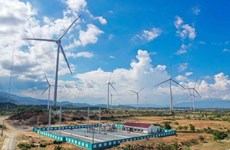Binh Dinh aims for friendly cassava cultivation
Fearing that the large scale cassava cultivation would lead to the
deforestation and the soil degradation, the Binh Dinh provincial
authorities have decided to put the cassava cultivation programme under
the control.
Fearing that the large scale cassava cultivation would lead to the
deforestation and the soil degradation, the Binh Dinh provincial
authorities have decided to put the cassava cultivation programme under
the control.
The stable and high prices of cassava in recent years, bringing high profits to farmers, have prompted Binh Dinh’s people to shift to grow cassava instead of other crops, the English language online newspaper VietNamNet Bridge reported.
As a result, the cassava growing area has been increasing rapidly, going far beyond the expectations.
Under the cassava development plan, the central province of Binh Dinh would have 10,000 hectares of cassava growing area by 2020.
This includes 4,400 hectares of stable cultivated area which provides materials to the local starch factory which makes products for export.
The total cassava growing area has reached 13,000 hectares, or 3,000 hectares higher than the area projected for 2020.
Cassava growing areas have been developed in many districts, including Van Canh, Phu Cat, Phu My, Tay Son, Vinh Thanh and An Lao.
According to the local authorities, it is easy and not costly to grow cassava, while the sale is stable. Therefore, growing cassava is the choice of many local people.
With the average yield of 25-30 tonnes per hectare and the selling price of 1.5-1.7 million VND per tonne, farmers can make a profit of 30 million VND per hectare, a high profit level if comparing with the other farm produce.
However, the “cassava movement” is threatening the existence of the forest. Local people tend to clear forest land to get site for cassava fields.
Especially, experts have warned that the massive development of cassava in the locality may lead to the soil degeneration. The current cassava growing land would not be suitable to other crops.
Therefore, the provincial authorities have taken drastic measures to minimize the risks, requesting farmers to strictly follow the land development programme and only grow the crops under the plans approved by the authorities.
Farmers have also been told to grow cassava together with other crops to help improve the soil.
According to Deputy Director of the Binh Dinh provincial Agriculture Department Ho Ngoc Hung, cassava will be developed only on suitable land, while the land with the slope of more than 15 degrees would be reserved for fruit trees, industrial trees or forestation in order to optimise the economic efficiency and help protect the environment.
A new method of cultivating cassava in the sustainable and environment friendly way has been used in Phu Cat district of Binh Dinh province.
Phan Sy Hung, Deputy Head of the district’s agriculture sub-department said one of the most important solutions in developing sustainable cassava material areas is to optimise the economic efficiency in the same cultivation area.
A lot of people here grow peanuts together with cassava, making the profits 2-3 times higher than the alternate peanut-cassava cultivation and 3.5 times higher than pure cassava cultivation.
Probiotics have been used by a lot of farmers here instead of chemical pesticide, thus allowing to reduce the insects, cut investment costs and improve the soil.
Vietnam has 560,000 ha under cassava cultivation and the output last year was 9.4 million tonnes. Around half of it is consumed domestically.
Over the recent years, cassava has become one of the products with high export value, according to the Ministry of Agriculture and Rural Development.
The export of cassava and cassava products was worth 952 million USD in 2011, a whopping 70 percent rise from 2010, and it went up by another 41 percent in 2012.
Cassava and cassava products were the seventh largest export staple in 2013. Exports of cassava and cassava products plunged by 18.2 percent to 1.1 billion USD last year, according to the General Department of Customs. Volumes were down almost 30 percent to 3.1 million tonnes.
In 2013, the country stood only behind Thailand in export of cassava products, which are now present in such regional countries as China, the Republic of Korea, Malaysia, Indonesia, India, Myanmar and Japan.-VNA
The stable and high prices of cassava in recent years, bringing high profits to farmers, have prompted Binh Dinh’s people to shift to grow cassava instead of other crops, the English language online newspaper VietNamNet Bridge reported.
As a result, the cassava growing area has been increasing rapidly, going far beyond the expectations.
Under the cassava development plan, the central province of Binh Dinh would have 10,000 hectares of cassava growing area by 2020.
This includes 4,400 hectares of stable cultivated area which provides materials to the local starch factory which makes products for export.
The total cassava growing area has reached 13,000 hectares, or 3,000 hectares higher than the area projected for 2020.
Cassava growing areas have been developed in many districts, including Van Canh, Phu Cat, Phu My, Tay Son, Vinh Thanh and An Lao.
According to the local authorities, it is easy and not costly to grow cassava, while the sale is stable. Therefore, growing cassava is the choice of many local people.
With the average yield of 25-30 tonnes per hectare and the selling price of 1.5-1.7 million VND per tonne, farmers can make a profit of 30 million VND per hectare, a high profit level if comparing with the other farm produce.
However, the “cassava movement” is threatening the existence of the forest. Local people tend to clear forest land to get site for cassava fields.
Especially, experts have warned that the massive development of cassava in the locality may lead to the soil degeneration. The current cassava growing land would not be suitable to other crops.
Therefore, the provincial authorities have taken drastic measures to minimize the risks, requesting farmers to strictly follow the land development programme and only grow the crops under the plans approved by the authorities.
Farmers have also been told to grow cassava together with other crops to help improve the soil.
According to Deputy Director of the Binh Dinh provincial Agriculture Department Ho Ngoc Hung, cassava will be developed only on suitable land, while the land with the slope of more than 15 degrees would be reserved for fruit trees, industrial trees or forestation in order to optimise the economic efficiency and help protect the environment.
A new method of cultivating cassava in the sustainable and environment friendly way has been used in Phu Cat district of Binh Dinh province.
Phan Sy Hung, Deputy Head of the district’s agriculture sub-department said one of the most important solutions in developing sustainable cassava material areas is to optimise the economic efficiency in the same cultivation area.
A lot of people here grow peanuts together with cassava, making the profits 2-3 times higher than the alternate peanut-cassava cultivation and 3.5 times higher than pure cassava cultivation.
Probiotics have been used by a lot of farmers here instead of chemical pesticide, thus allowing to reduce the insects, cut investment costs and improve the soil.
Vietnam has 560,000 ha under cassava cultivation and the output last year was 9.4 million tonnes. Around half of it is consumed domestically.
Over the recent years, cassava has become one of the products with high export value, according to the Ministry of Agriculture and Rural Development.
The export of cassava and cassava products was worth 952 million USD in 2011, a whopping 70 percent rise from 2010, and it went up by another 41 percent in 2012.
Cassava and cassava products were the seventh largest export staple in 2013. Exports of cassava and cassava products plunged by 18.2 percent to 1.1 billion USD last year, according to the General Department of Customs. Volumes were down almost 30 percent to 3.1 million tonnes.
In 2013, the country stood only behind Thailand in export of cassava products, which are now present in such regional countries as China, the Republic of Korea, Malaysia, Indonesia, India, Myanmar and Japan.-VNA












